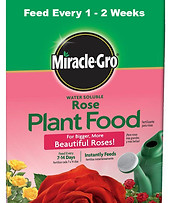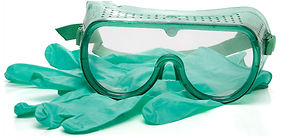How To Fertilize
Plants and Lawns
TEN TIPS

1. Identify Fertilizer Needs

It's best to know which parts of your yard and garden require regular feeding
with a carefully chosen fertilizer. Your lawn will be greener and healthier with a nitrogen based lawn fertilizer, be it a granular or water soluble formulas. If it's your fruit trees or roses, they might perform better with a specialty fertilizer. Tender bedding plants and shrubs might do best with a top dressing of processed animal manures, or composted vegetation. We'll discuss several of them here.
2. Synthetic vs. Organic

Synthetic fertilizers generally cost less and last longer in the soil.
Organic formulas usually cost more and require more applications in a season.
Synthetics usually include mainly MACROnutrients in their formulas and are manufactured into pellet or flake forms for application.
Organic fertilizers are typically blends of macro and MICROnutrients, especially formulated for specific plant groups. Organics are typically lightweight and powdery as they are blend of dried organic materials like feathers, bone,
3. Fertilizer Formulas
Plant fertilizers are compounds of the chemical elements Nitrogen (N), Phosphorus (P), and Potassium (K) ( Potash ) packaged as the MACROnutrient formula N-P-K. Example: 10-10-10 is a complete and balanced formula, based on weight. This is recognized as the base line of fertilizer formulas. Formulas increase or decrease by individual macronutrients. 16 - 8 - 10 is a complete formula. In a 50 pound bag, 16% is N, 4% is P, and 8% is K by weight. Some fertilizers, especially organic, make a point of listing the MICROnutrients included as helpful supplemental nutrients. Specialized compounds can be formulated with 0% of any of the elements. 0 - 10 - 10 is a formula deliberately devoid of nitrogen as this fertilizer will specifically promote blooming, without adding a " green it up " ingredient.
4. Right Dosage

Many home owners are guilty of too little fertilizing. And, occasionally too much. The results of too little are usually characterized by yellowing, and lack of healthy appearance in leaves, including blades of lawn grasses. Establishing a regular schedule of fertilizing will usually correct deficiencies, especially nitrogen, which is almost always a boost in “ greening up “ nitrogen deficient plants and grasses. Each fertilizer formula will come with instruction on how much to use, how often. If you are fertilizing your lawns once each quarter and your yard once in the Spring and Fall . . . you are well ahead of most home gardeners.Still, applying too much, too often can damage plants and disrupt their natural cycles.
5. Scheduling Fertilizers

Cultivated plants ( not wild ) benefit from regular applications of a formulated fertilizer. Some plants do best with one prescribed application in early spring to promote leave, stem and blossom development sufficient to last until the second application in the fall to prepare the plant for the rigors of winter. Other plants, like ever-bearing citrus, producing tomatoes, and blooming roses will benefit from monthly feedings of an organic specialty formula.
6. Dry Fetilizers

Dry fertilizers are most commonly associated with lawns. They can be purchased in large packages. 20 pound bags are most common, and easily measured for application in a mechanical spreader. Just fill the hopper. Most 20 pound bags applied with the manufacturers recommended spreader setting will cover approximately 5,000 square feet of lawn, one time. Convenient dry specialty fertilizers are available for trees, shrubs and flowers ready right out of the bag in doses suggested on the package.
7. Water Soluble Fertilizers

Some folks still like to mix fertilizer powder formulas with water and pour or spray individual plants in the yard or garden. Miracle Grow makes a full line of water soluble formulas for every imaginable plant category. Because they are highly diluted, water solubles required more frequent applications. A 2 gallon watering can, or mix on board hose end sprayer both make water solubles easy to apply.
8. Lawn Applicators

Dry spreaders come in two types, drop and rotary. The handheld rotary applicator is preferred by most home gardeners. Fill and begin on the side of the lawn. Make one pass, turn and repeat the pass overlapping by a foot or so. This prevents green stripes form in your lawn. Most dry lawn formulas are best applied with the rotary spreader trigger opener set on 5.
9. Miracle Lawn Restorer

I have many followers who have turned their lawns around, and like me, have come to swear by this product. In my case to was the healing of two watermelon sized dog urine burns from my dog's late life crisis. For many others, it was the miracle that changed their neglected or damaged lawn for good. Myself and others have made it a habit to treat my lawn to a regular monthly application of REVIVE® ( liquid or granule ) to endure that it stays healthy and thriving.
10. Cautions
It is good practice to treat all gardening product with respect. Fertilizers are no exception. When handling synthetic fertilizers wear gloves and eye protection, especially on windy days. ( A single flake of lawn fertilizer once sent my wife to the ER with her eye bulging our of its socket. ). Always wash your hands after handling fertilizer. If you spill granular fertilizer on walks or drives,
be sure to sweep it up, before it gets wet, to avoid staining. Finally, don't apply high nitrogen lawn fertilizers on those days where temperatures will reach 90+.

